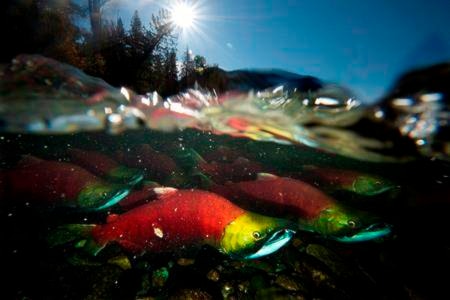VANCOUVER — Federal fisheries experts are painting a devastating picture of the challenges facing Pacific salmon and point to climate change as the main culprit.
Fisheries Minister Jonathan Wilkinson said that 2019 has been an especially difficult year in what has been a decades-long decline in stocks, after his department released a new report on the state of wild Pacific salmon.
“There is no question that climate change is having a significant impact on our salmon,” he said Thursday at a news conference in Vancouver.
“Not only do these declines have direct impacts on our ecosystems and the health of our environment, but they have serious impacts on the health of our economy.”
In one of the most dramatic shifts, the federal department has adjusted the number of returning Fraser River sockeye expected this year to about 625,000, down from an earlier projection of nearly five million.
Twelve out of 13 Fraser River chinook populations have been recommended for protection under the Species at Risk Act, while coho returns in Alaska and Skeena River sockeye returns also prompted significant fisheries closures.
Wilkinson also announced $2.7 million for five projects under the British Columbia Salmon Restoration and Innovation Fund.
“Part of any realistic plan to protect and ultimately restore key salmon stocks must include a comprehensive and aggressive plan to reduce carbon emissions,” he said.
Ottawa is working actively with stakeholders, the province and First Nations to develop a long-term approach, he said.
Wilkinson noted that the new Fisheries Act restores protections for fish and fish habitat, while the government is also working to restore habitat affected by industrial development, increase fisheries management and assess impacts of threats like predators.
Sue Grant, one of the report’s authors, said some of the declines are residual effects of larger climate change events like “The Blob,” an enormous mass of warm water caused by a heat wave in the North Pacific.
The Blob had significant impacts on the food web and prompted large fatty zooplankton, the primary food of Pacific salmon, to migrate north and be replaced by a much smaller, less nutritious species, she said.
“Everything we’re seeing in salmon and ecosystem trends is embedded within this larger context,” she said, adding that Canada is warming at a rate double the global average and the rate increases at northern latitudes.
“The planet is warming and the most recent five years have been the warmest on the planet’s record.”
The report says that air and water temperatures in B.C. and Yukon are increasing, while changing precipitation patterns are altering freshwater habitats. These effects are compounded by human activity that alters the landscape.
Species like pink salmon that spend less time in freshwater are showing fewer declines, suggesting they are less vulnerable to climate change.
The report comes as officials continue to work around the clock to clear a barrier along the Fraser River blocking the migration route of millions of salmon.
“This is undoubtedly a crisis situation,” Wilkinson said of the landslide, adding that the maximum 100 staff are on the case.
About 270,000 salmon have been recorded in the river below the barrier, while only 26,000 have been moved upstream, primarily via helicopter, he said.
